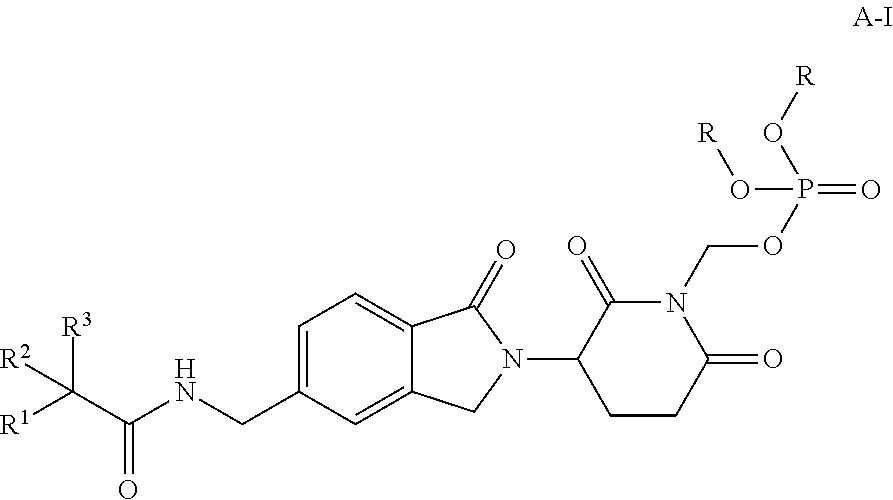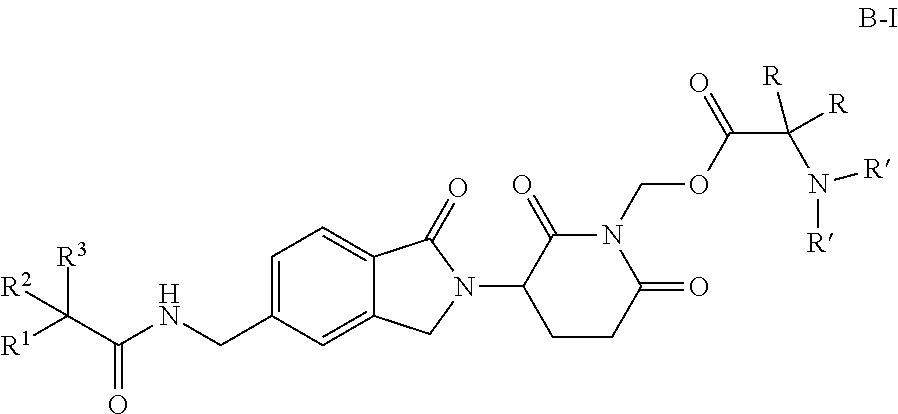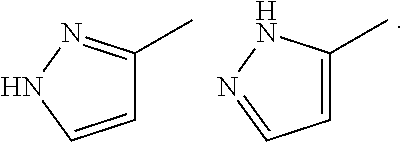Antiproliferative compounds, and their pharmaceutical compositions and uses
a technology of antiproliferative compounds and compositions, applied in the field of antiproliferative compounds, and their pharmaceutical compositions and uses, can solve the problems of limited treatment options, few treatment options available, and approaches that pose significant drawbacks to patients, and achieve safe and effective methods of treating, reducing or avoiding toxicities and/or side effects.
- Summary
- Abstract
- Description
- Claims
- Application Information
AI Technical Summary
Benefits of technology
Problems solved by technology
Method used
Image
Examples
example 1
Preparation of (3-(5-((2,2-difluoro-2-(4-fluorophenyl)acetamido)methyl)-1-oxoisoindolin-2-yl)-2,6-dioxopiperidin-1-yl)methyl Dihydrogen Phosphate
[0570]
A. Methyl 4-bromo-2-methylbenzoate
[0571]4-Bromo-2-methylbenzoic acid (100 g, 465.02 mmol), concentrated sulfuric acid (52 mL) in methanol (1 L) were combined and heated to 65° C. for 18 hours. The reaction was concentrated and the residue diluted with ethyl acetate (500 mL), washed with saturated sodium bicarbonate solution (150 mL), water (200 mL), and brine (250 mL) and dried over sodium sulfate. The organic phase was concentrated under reduced pressure and further dried under high vacuum to give methyl 4-bromo-2-methylbenzoate (102 g, 445.27 mmol, 95% yield) as a red liquid. 1H NMR (400 MHz, Chloroform-d1) δ 7.78 (d, J=8.3 Hz, 1H), 7.45-7.30 (m, 2H), 3.88 (s, 3H), 2.57 (s, 3H).
B. Methyl-4-bromo-2-(bromomethyl) Benzoate
[0572]Methyl 4-bromo-2-methylbenzoate (102 g, 445.27 mmol), NBS (79.2 g, 445.27 mmol), Azo-isobutyronitrile (2.58 g...
example 2
Preparation of (3-(5-((2,2-difluoro-2-(4-fluorophenyl)acetamido)methyl)-1-oxoisoindolin-2-yl)-2,6-dioxopiperidin-1-yl)methyl L-Valinate
[0583]
A. Methyl 4-bromo-2-methylbenzoate
[0584]4-Bromo-2-methylbenzoic acid (100 g, 465.02 mmol), concentrated sulfuric acid (52 mL) in methanol (1 L) were combined and heated to 65° C. for 18 hours. The reaction was concentrated and the residue diluted with ethyl acetate (500 mL), washed with saturated sodium bicarbonate solution (150 mL), water (200 mL), brine (250 mL) and dried over sodium sulfate. The organic phase was concentrated under reduced pressure and further dried under high vacuum to give methyl 4-bromo-2-methylbenzoate (102 g, 445.27 mmol, 95% yield) as a red liquid. 1H NMR (400 MHz, Chloroform-dl) δ 7.78 (d, J=8.3 Hz, 1H), 7.45-7.30 (m, 2H), 3.88 (s, 3H), 2.57 (s, 3H).
B. Methyl-4-bromo-2-(bromomethyl) Benzoate
[0585]Methyl 4-bromo-2-methylbenzoate (102 g, 445.27 mmol), NBS (79.2 g, 445.27 mmol), Azo-isobutyronitrile (2.58 g, 16 mmol) in ...
example 3
[0593]The following is an example of an assay that can be used to determine the anti-proliferative activity of Compound A and Compound B in KG-1 cell line (American Type Culture Collection [ATCC]: catalogue number ATCC® CCL-246™) at 72 hours post-treatment. The seeding density for KG-1 can be optimized to ensure assay linearity in 384-well plates.
[0594]Increasing concentrations of test compounds (0.5 nM to 10 μM) was spotted in a 10-point serial dilution fashion (3-fold dilution) in duplicate via an acoustic dispenser (EDC ATS-100) into an empty 384-well plate. The dimethyl sulfoxide (DMSO) concentration was kept constant for a final assay concentration of 0.1% DMSO. Prior to testing, KG-1 cells were grown in RPMI-1640 (Roswell Park Memorial Institute-1640) medium with 10% FBS (fetal bovine serum: HyClone) and expanded in culture flasks to provide sufficient amounts of starting material. Cells were then diluted to 5000 cells per well, in a 50 μL volume and added d...
PUM
| Property | Measurement | Unit |
|---|---|---|
| concentration | aaaaa | aaaaa |
| body weight | aaaaa | aaaaa |
| time | aaaaa | aaaaa |
Abstract
Description
Claims
Application Information
 Login to View More
Login to View More - R&D
- Intellectual Property
- Life Sciences
- Materials
- Tech Scout
- Unparalleled Data Quality
- Higher Quality Content
- 60% Fewer Hallucinations
Browse by: Latest US Patents, China's latest patents, Technical Efficacy Thesaurus, Application Domain, Technology Topic, Popular Technical Reports.
© 2025 PatSnap. All rights reserved.Legal|Privacy policy|Modern Slavery Act Transparency Statement|Sitemap|About US| Contact US: help@patsnap.com



